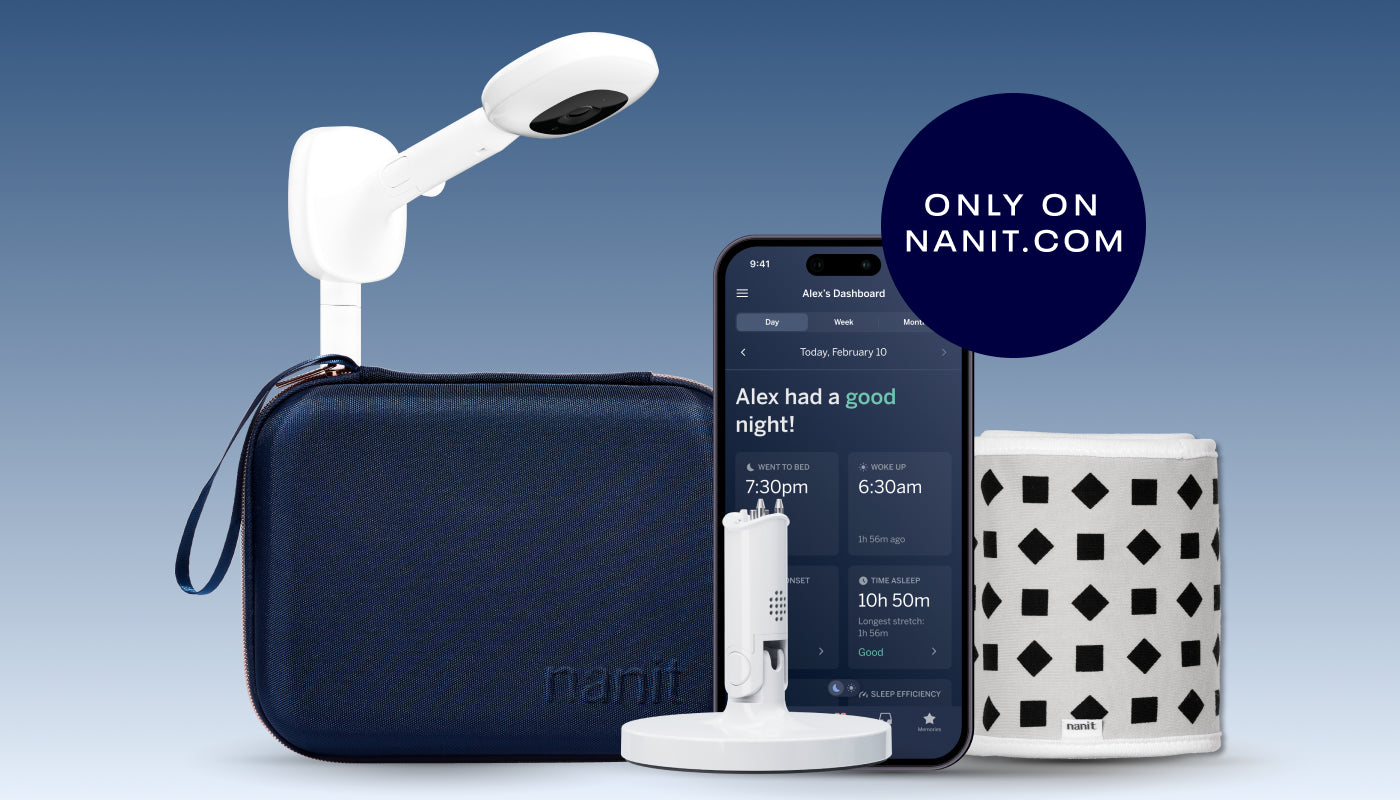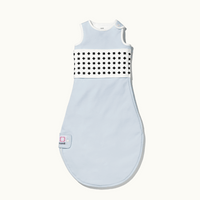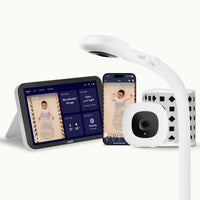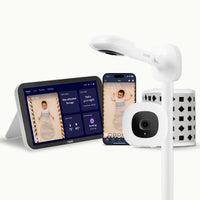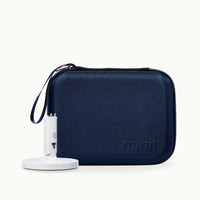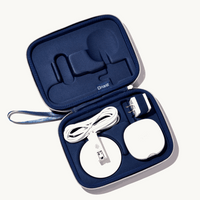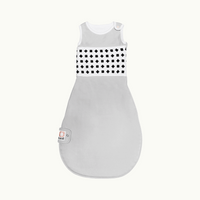Reviewed by Nanit Lab's Dr. Natalie Barnett.
What is swaddling and why do we swaddle babies?
The journey back from the hospital after welcoming your baby is a unique experience. As you watch the hospital fade away in your rearview mirror, you're hit with the realization that your little one is relying on you. It's a wonderful responsibility.
Your days and nights are now a mix of various activities. Feeding, cleaning, and diaper changes become your routines, each infused with care and affection. Among these tasks, one that might initially appear straightforward but can be quite engaging is helping your baby drift off to sleep during those early months. Enter swaddling– an age-old practice that can help soothe your child and promote sleep.
But what is swaddling, exactly? And why swaddle a newborn baby? Let’s explore these questions and learn more about how this technique makes it easier for babies to fall asleep amidst the whirlwind of new (and sometimes baffling) parenting must-do’s.
What is swaddling?
As a parent, your primary directive is to provide comfort and security to your newborn. Swaddling does both.
Swaddling is the art of gently cocooning an infant in a soft, thin blanket while securing baby’s arms in a snug embrace that gently restricts their movement and leaves the baby’s head exposed. (This sounds a bit much, but trust us—they love the comfort.)
This practice is more than just about wrapping up the baby—it's about understanding and catering to the infant’s primal needs. In a world that’s bright, loud, and chaotic to their newly awakened senses, the tight wrapping provides a sense of containment and security that mirrors the familiar confines of the mother’s womb.
The result? A calmer, more content baby that is better equipped to rest peacefully and adjust to the outside world.
Why do we swaddle babies? A history of swaddling
The practice of swaddling has been used for millennia. From the artwork in Cyprus and Crete to votive statuettes in Rome, to biblical accounts of baby Jesus, the technique can be traced across various cultures throughout much of antiquity.
Back then, however, the ancients didn't view swaddling merely as a soothing technique. For them, it served a more utilitarian purpose. It transformed wriggly, fragile newborn infants into compact, manageable bundles that were easier to carry and transport, especially for nomadic tribes constantly on the move.
Moreover, ancient cultures believed that swaddling played a developmental role that helped shape the physical growth of a child. The practice, as referenced in ancient texts, involved wrapping the child tightly in cloth bands, almost like bandages. They figured that the structure would prevent deformities, helping the baby grow with strong and straight limbs.
However, like all practices, swaddling has had its ebbs and flows. By the 17th century, it had largely fallen out of favor, only to experience a mainstream resurgence in the ‘90s when the American Academy of Pediatrics (AAP) recommended that infants sleep on their backs to help with SIDS prevention.
The “Back to Sleep” Campaign
For most of the 20th century, medical wisdom held that infants should sleep on their stomachs, a position known as prone sleeping. While this posed no apparent problem for the majority of infants, an alarming surge in Sudden Infant Death Syndrome (SIDS) cases caused medical researchers to rethink this position.
As experts studied the matter, they developed what’s known as the triple-risk model, which suggests that SIDS is the culmination of three coinciding factors. According to the Association of American Family Physicians:
“This model proposes that an infant must first have an underlying vulnerability and then be stressed by an exogenous source, such as prone sleeping placement. Finally, for SIDS to occur, the stress must occur during a critical developmental period, namely in the first year of life.”
In a bid to mitigate the second risk factor—the stress from external sources, like prone sleeping—the National Institutes of Health (NIH) and the AAP joined forces. Together, they launched the "Back to Sleep" campaign, a public health initiative that challenged traditional baby sleep practices by advocating for babies to sleep on their backs (supine position) rather than their stomachs.
Swaddling returns to the mainstream
The results of “Back to Sleep” were instant and remarkable, making it one of the most effective public health campaigns in modern times. Since its introduction, the rate of SIDs in the US has declined by more than 50%—a testament to the power of rethinking sleeping positions.
The campaign's ripple effects didn’t end there. In a roundabout way, the "Back to Sleep" campaign also paved the path for the resurgence of swaddling. As infants were encouraged to sleep on their backs, parents noticed an increase in sleep disturbances and a heightened "startle reflex." They sought out solutions to ensure their little ones could sleep safely and soundly.
As a result, the ancient practice of swaddling reemerged into the limelight and instantly catapulted into mainstream consciousness, providing a tried-and-tested solution to the new challenges posed by the back-sleeping guidelines.
Benefits of swaddling
There's a reason why swaddling has been in the parental playbook for thousands of years and why it's once again front and center in the baby care arena.
That’s because the benefits of swaddling are undeniable, including:
Soothes babies
Even for adults, the world can sometimes feel like too much to handle with all its noise and activity. For babies, it's even more overwhelming as their senses are still learning and growing.
For nine months, your baby enjoyed the constant, warm embrace of their mother’s womb. In that calm cocoon of safety, there’s no sound or sensation besides the steady thrum of the mother’s heartbeat and the soothing, muffled cadence of her voice.
Suddenly, they’re out in the loud, bright, big world. A baby swaddle, however, provides a soothing balm that mimics the calming sense of enclosure within the mother’s womb. It acts as a comforting buffer, lending a sense of security that helps ease the baby’s transition into their new life.
Better sleep
If parents want to catch some sleep, then their baby will need to go to sleep first and stay in a deep slumber. Swaddling can help with this, especially for babies sleeping on their backs.
According to the first systematic review and narrative synthesis ever conducted on the subject, researchers discovered that: “Swaddling was associated with increased duration of quiet sleep in infants and a significantly reduced number of sleep state changes among infants naïve to the intervention.”
That said, as researchers noted, exactly how impactful swaddling was dependent on several factors, including:
- Habituation (routine vs. non-routine swaddling)
- Sleep stages
- Sleep environment
- Swaddle technique
- Swaddle tightness
Reduces the startle reflex
Have you ever watched your baby seemingly jump in their sleep? That's the Moro reflex, more popularly known as the startle reflex. This involuntary response makes the newborn baby feel as though they were falling, causing them to react by spreading their arms and then quickly closing them.
Although this is entirely normal, it can cause a peacefully sleeping baby to jolt wide awake, which is the last thing a tired parent wants to occur. However, swaddling appears to be an effective counter to the Moro reflex. According to a study on spontaneous arousals in supine infants, researchers discovered that:
“Swaddling has a significant inhibitory effect on progression of arousals from brainstem to full arousals involving the cortex in quiet sleep. Swaddling decreases spontaneous arousals in quiet sleep and increases the duration of REM sleep, perhaps by helping infants return to sleep spontaneously, which may limit parental intervention.”
Put simply, by softly securing the baby’s arms, this physical boundary can significantly reduce startle-induced awakenings, leading to less disruption and more uninterrupted sleep for both baby and parents.
The shortcomings of swaddling blankets
For the better part of the '90s and early '00s, the standard swaddling practice involved wrapping baby in a large, thin swaddling blanket or swaddling cloth. Now, what once was a must-have item in every nursery, is being reevaluated.
Swaddling can feel like origami art, and when it’s the middle of the night and you’re half-awake, attempting to get the perfect swaddle can be a challenge.
Achieving the perfect snugness is a skill—too loose, and the baby escapes, too tight, and it's uncomfortable, potentially risky. Even when done properly, some infants may resist, simply preferring freedom of movement over any restriction. So, learning how to properly swaddle a baby, how long to swaddle a baby per day, and even what age to stop swaddling is essential for both their comfort and safety.
Parents craved a practical, hassle-free alternative—one that was easy to put the baby in. This gave rise to the era of modern swaddling solutions.
Nanit and the modern evolution of the baby swaddle
Enter the new era with Nanit, a tech-forward brand redefining the swaddling experience for the 21st-century parent and their little one. These modern updates to the traditional swaddle aren’t just cute, convenient, and comfortable. The breathing wear pattern on the Nanit Breathing wear swaddle connects to the Nanit Pro Camera and can detect your baby’s breathing motion–without sensors, electronics, or radars.
If you're looking to soothe your baby, promote better sleep, and reduce their startle reflex, explore our range of baby sleep wear essentials like the Breathing Wear Swaddle and Sleep Wear Swaddle. By adding swaddling to your toolkit, our bet is that you and your little one are in for healthier, more restful nights of sleep.
Editorial Team
Dr. Natalie Barnett:
 Natalie Barnett serves as VP of Clinical Research at Nanit. Natalie initiated sleep research collaborations at Nanit and in her current role, Natalie oversees collaborations with researchers at hospitals and universities around the world who use the Nanit camera to better understand pediatric sleep and leads the internal sleep and development research programs at Nanit. Natalie holds a Ph.D. in Genetics from the University of New England in Australia and a Postgraduate Certificate in Pediatric Sleep Science from the University of Western Australia. Natalie was an Assistant Professor in the Neurogenetics Unit at NYU School of Medicine prior to joining Nanit. Natalie is also the voice of Nanit's science-backed, personalized sleep tips delivered to users throughout their baby's first few years.
Natalie Barnett serves as VP of Clinical Research at Nanit. Natalie initiated sleep research collaborations at Nanit and in her current role, Natalie oversees collaborations with researchers at hospitals and universities around the world who use the Nanit camera to better understand pediatric sleep and leads the internal sleep and development research programs at Nanit. Natalie holds a Ph.D. in Genetics from the University of New England in Australia and a Postgraduate Certificate in Pediatric Sleep Science from the University of Western Australia. Natalie was an Assistant Professor in the Neurogenetics Unit at NYU School of Medicine prior to joining Nanit. Natalie is also the voice of Nanit's science-backed, personalized sleep tips delivered to users throughout their baby's first few years.Sources:
Roman Times. Roman and Etruscan worship of Amphiaraus. https://ancientimes.blogspot.com/2020/09/roman-and-etruscan-worship-of-amphiaraus.html
Bible Hub. Luke 2:7. https://biblehub.com/kjv/luke/2-7.htm
American Academy of Pediatrics. SIDS and Other Sleep-Related Infant Deaths. https://publications.aap.org/pediatrics/article/128/5/1030/30941/SIDS-and-Other-Sleep-Related-Infant-Deaths
AAFP. Sudden Infant Death Syndrome. https://www.aafp.org/pubs/afp/issues/2009/0515/p870.html
NEJM. How Risk Factors for SIDS Have Changed Since the Back-to-Sleep Campaign. https://www.jwatch.org/pa201204250000001/2012/04/25/how-risk-factors-sids-have-changed-back-sleep
NIH. The effect of swaddling on infant sleep and arousal: A systematic review and narrative synthesis. https://www.ncbi.nlm.nih.gov/pmc/articles/PMC9748185/
NIH. Spontaneous arousals in supine infants while swaddled and unswaddled during rapid eye movement and quiet sleep. https://pubmed.ncbi.nlm.nih.gov/12456937/


